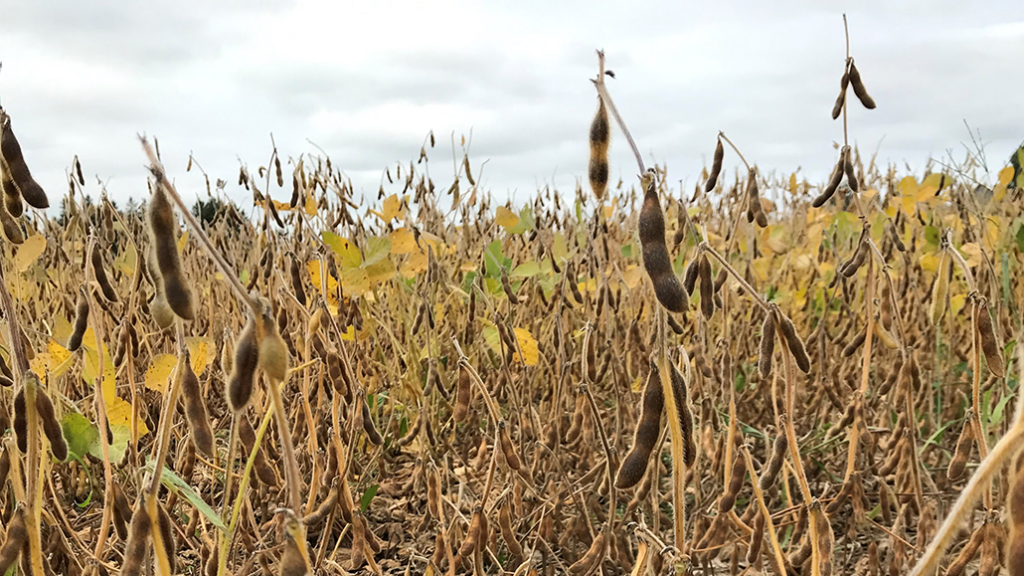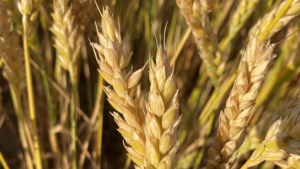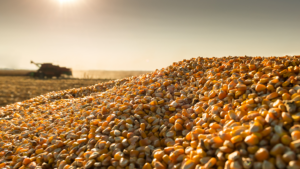Demand for Canadian soybeans
REMAINING STRONG IN A VOLATILE WORLD

GLOBAL CONFLICT AND inflation have made markets incredibly volatile in 2022. With the Russian invasion of Ukraine sending markets into chaos and many countries still recovering from the impacts of the global pandemic, commodity markets have been on a roller coaster.
Despite volatility, global demand for soybeans is strong and continues to grow. Increased demand for poultry feed in the middle east, renewed interest in biofuels in the United States, and strengthened soy food consumption in Asia and West Europe are all driving soybean demand.
As the world’s fifth largest soybean exporter, Canada is well-positioned to help fill this growing demand for commodity and non-GMO food-grade soybeans. Our incredible growers and a world-leading value chain make us an important supplier of sustainable sources of protein and oil for a hungry world.
In 2021 Canadian soybean exports were 4.4 million metric tonnes (162 million bushels), representing approximately 70 per cent of production.
Once led by China and the European Union, export markets for Canadian soybeans have shifted over the past four years, with Iran now the largest single destination. With a growing poultry industry seeking cost-competitive feed options and shifting geopolitics, Canadian exports have seen significant growth to the country.
CHINA’S IMPACT
China is the world’s largest soybean market. Recently, Chinese demand has slowed due to continued Covid-19 restrictions, slow economic growth, and a drop in pork consumption. While increased demand is anticipated for the marketing year 2022 – 2023 (September to August), import projections remain lower than volumes seen before the pandemic.
Helping to offset lower demand from China is renewed interest in biofuels from the United States, Canada, and other developed countries. Leading the way is renewable diesel, a “drop-in” renewable fuel for diesel engines that can be blended at any level with fossil diesel. Seen as a green solution to help reduce greenhouse gas emissions, significant investment is occurring due to government regulations that favour low-carbon fuels and major investments by oil companies and private industry.
The market potential for soybean oil as a low-carbon feedstock for renewable diesel is significant and is causing a major shift in U.S. soybean demand and an unprecedented expansion of soybean processing capacity. It is estimated that renewable diesel capacity in the United States will reach 6.5 billion annual gallons by 2030. This expansion is driving demand for vegetable oils, including soybean oil, and will change the mix of soybeans and soy products available for export from North America as more soybeans are processed in North America.
FOOD-GRADE SOYBEANS
With the global soyfood industry projected to grow 5.6 per cent over the next three years to reach $55 billion, demand for food-grade soybeans continues to outpace supply.
For over forty years, Canada has been a global leader in producing quality, sustainable food-grade soybeans for international markets. With 1.2 million metric tonnes (44 million bushels) produced each year, virtually all of this production is exported to over twenty countries worldwide. While exports to traditional markets such as Japan remain stable, significant growth has occurred in new areas such as Indonesia, creating more demand for Canadian food-grade soybeans.
JAPAN
Japan continues to be an important market for Canadian food-grade soybean exports. It is the third-largest market for food-grade soybeans and the sixth-largest overall.
Soy food consumption within the country has remained stable for the past decade. While some sectors have seen growth, others continue to decline as consumer diets evolve.
Tofu remains the largest soy food sector within the country, with 60 per cent of total food-grade soybean usage. The sector has remained stable over the past two years, with the increase in at-home consumption balancing the losses in the hospitality and food sectors.
Natto is the second largest soy food sector, making up 20 per cent of the market. It has seen a resurgence over the past two years as consumers look for food options that help keep them healthy and strong.
While miso is the third largest soy food sector making up 15 per cent of the market, consumption has been on a declining trend for the past 10 years as consumers look to new products and consolidation in the industry continues over rising costs.
As the smallest soy food sector in Japan, soymilk consumption had been increasing year over year before the pandemic but has stabilized over the past two years due to consumers being at home and not visiting street markets or retail stores where soymilk was previously purchased.
SOUTHEAST ASIA
A quarter of the world’s soy food consumption is in Southeast Asia, making it the world’s largest soy food product market.
Southeast Asia also represents the largest food-grade soybeans market, which has seen significant growth over the past several years. Since 2017, Canadian food-grade soybean exports have increased by 60 per cent. Leading this is exports to Indonesia which have grown from 0.005 million metric tonnes to 0.30 million metric tonnes in five years.
Demand for soy food saw a sharp rise during the pandemic as consumers looked for healthy, easy-to-eat meals at home. While pandemic restrictions have been lifted in several parts of the region, a recent study by Nielsen showed that soy food consumption patterns are here to stay as consumers look to re-prioritize eating at home. This shift is attributed to the transformation in the delivery of soy food. While the move to digitization was occurring before the pandemic, the past two years have accelerated it even further. While in the past, consumers would purchase their soy food products at retail, several have switched to online delivery creating new demand opportunities for products.
EUROPE
While Asia continues to be the leader in soy food consumption, with 75 per cent of the market, western Europe is emerging as a new soy food hub. According to the Global Soy Food Market Overview report by the United States Soybean Export Council, the total western European soy food market has grown at a compounded annual growth rate of 1.4 per cent over the past five years and is now valued at $2 billion.
With a sizeable portion of consumers looking to reduce their meat consumption and adopt more flexitarian diets, consumers are turning to soy food as a high-protein alternative. While soy milk leads the market in value and volume, consumption has declined due to the emergence of other plant-based beverages, such as oat and almond.
Tofu and meat alternatives have been the fastest-growing segments seeing a ten per cent and seven per cent compounded annual growth rate over the past five years.
WHAT DOES IT MEAN FOR CANADA?
As populations, income levels, and urbanization expand worldwide, demand for sustainable feed grains and protein meals from soybeans will continue to grow. With incredible growers and a world-leading value chain, Canada is well-positioned to meet this demand with sustainable sources of protein and oil for a hungry world.
Nicole Mackellar is the market development manager for Soy Canada.
INDONESIA
Located in Southeast Asia, Indonesia is the largest island complex in the world, spreading across a chain of thousands of islands between Asia and Australia. It is the third most populous country in Asia and the fourth most populated country, following China, India, and the United States.
Soy is an important part of the Indonesian diet and a primary protein, especially for the less wealthy. A rapidly growing population and rising income levels are helping grow the demand for soybeans for soy food consumption. The current demand for soybeans in soyfood is 3 million metric tonnes, with 90 per cent used for tempeh and tofu manufacturing, two popular soyfood products.
For many Indonesians, tempeh and tofu are staple dishes and the main source of protein in their everyday diets and are often consumed as a meat replacement. Tempeh is made by fermenting soybeans allowing them to bind into a cake form and generate an earthy flavour. Tofu is a soybean curd made from coagulating soy milk and then pressing the resulting curds into solid white blocks of varying softness.
Despite the country’s fertile volcanic soil and tropical climate, Indonesia’s soybean production is low. As a result, it cannot meet local demand, making the country dependent on imports. Most imported soybeans are genetically modified, with price being the number one factor driving consumer purchases
Canada has emerged as a leader in soybean exports to the country over the past five years and is now the second largest exporter, following the United States. With over 0.3 million metric tonnes of soybeans exported, it represents the third largest market for Canadian soybean exports. •










